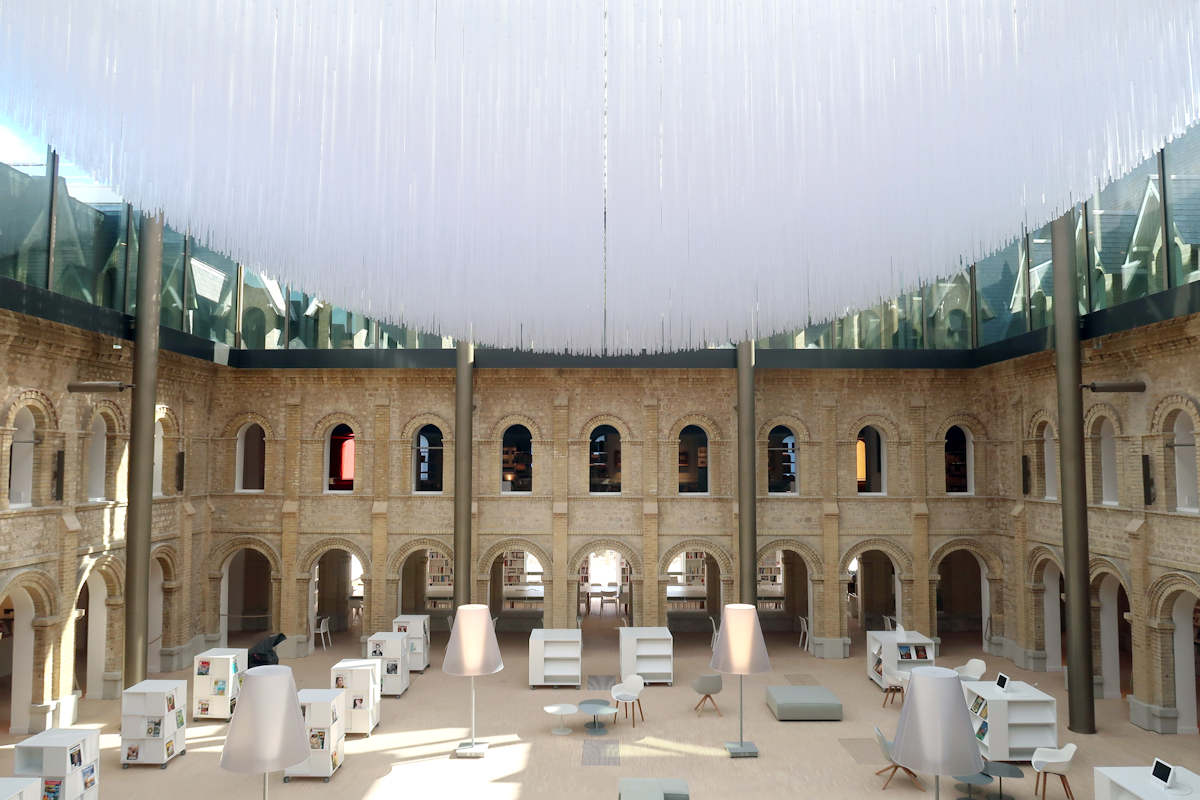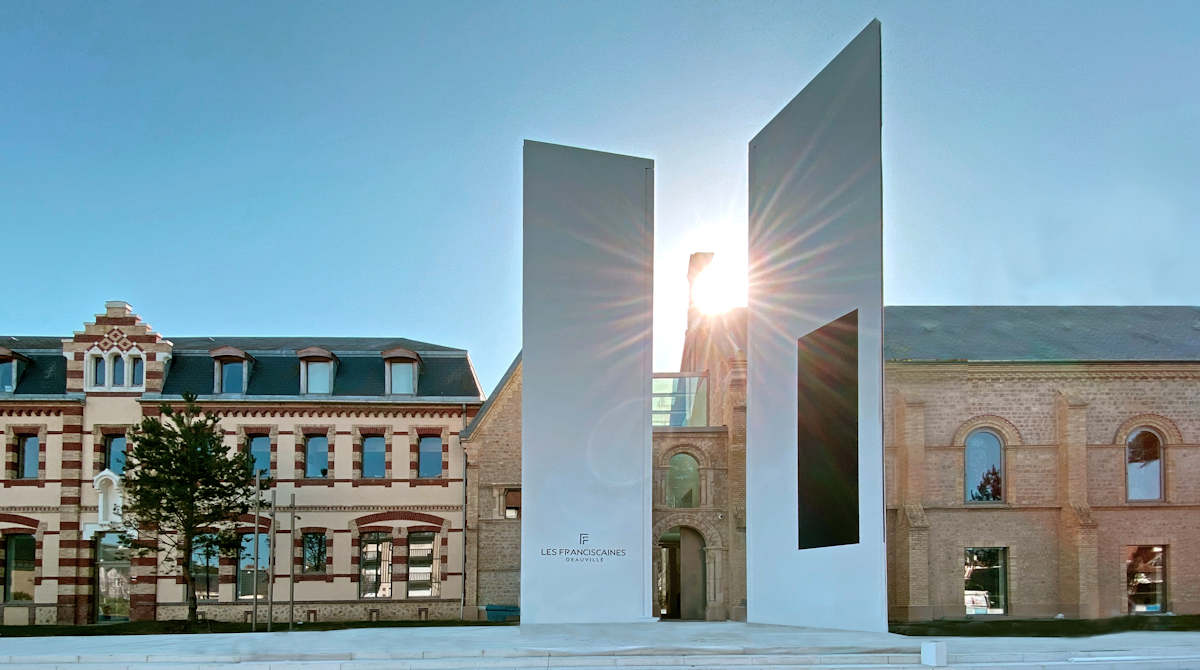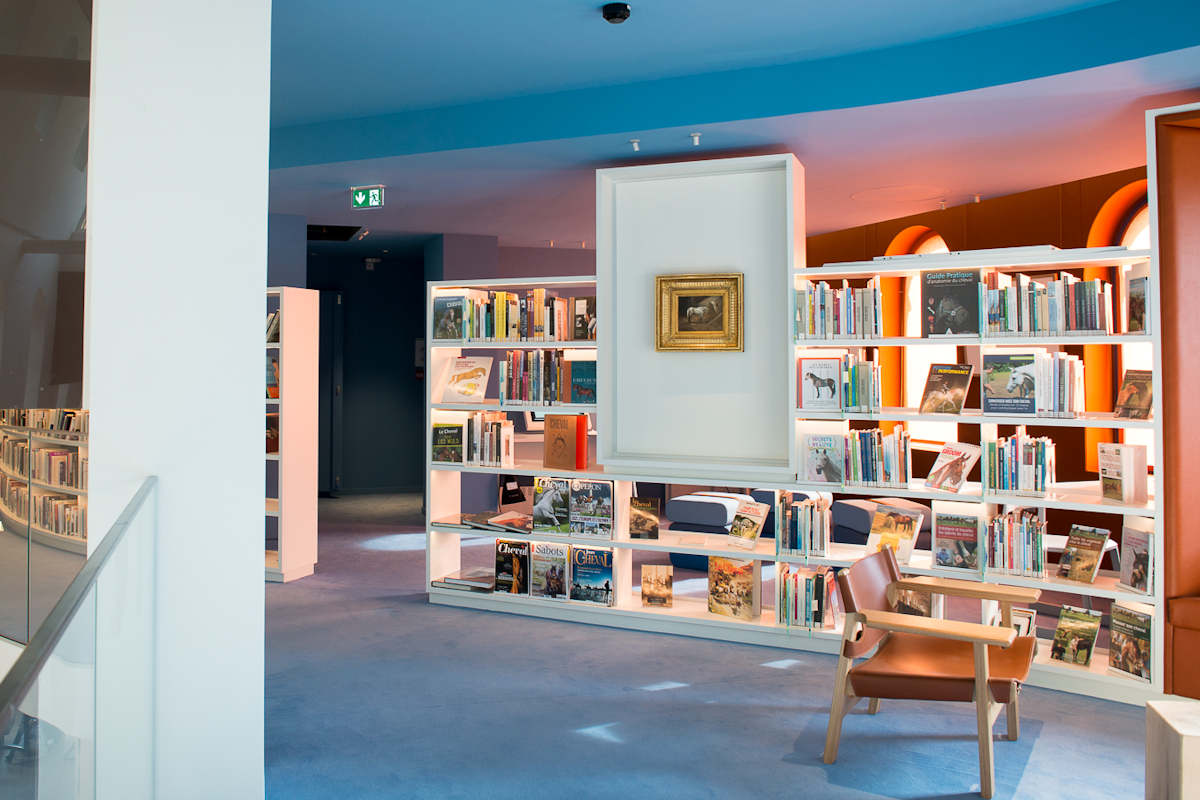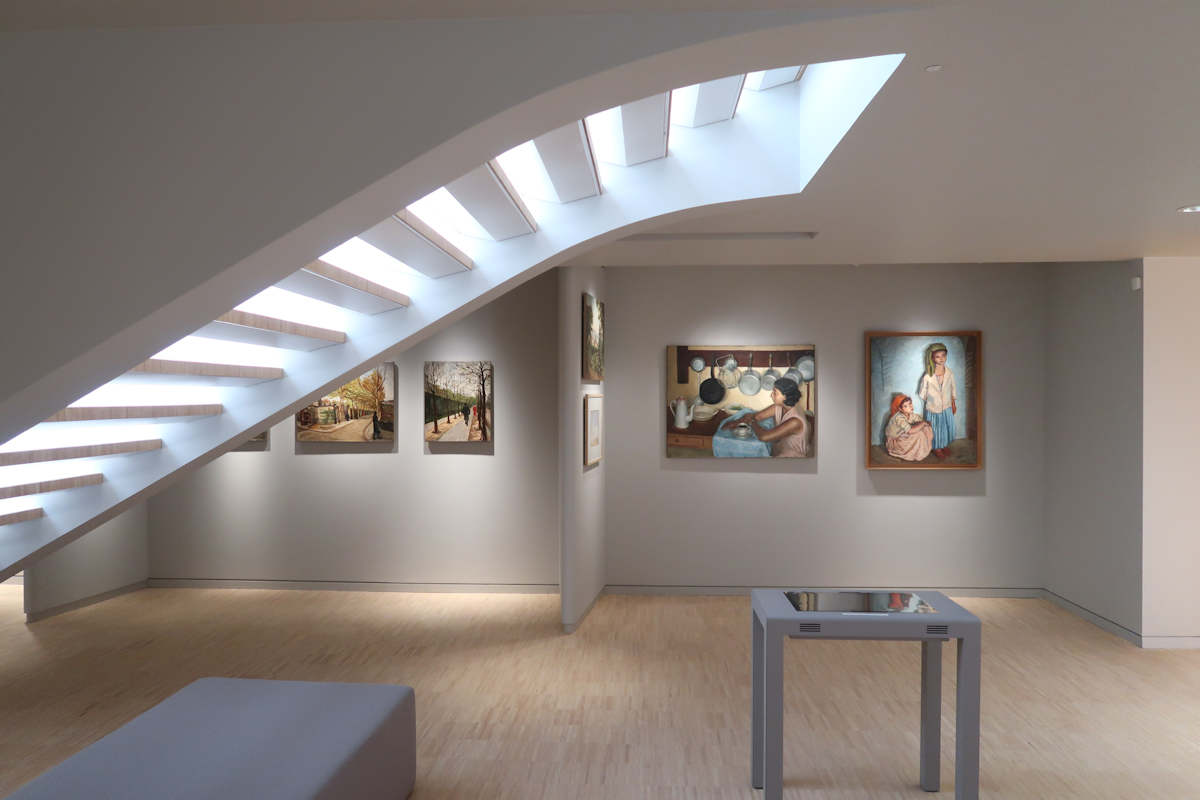
Corinne LaBalme took a daytrip to Deauville, Normandy’s premier luxury seaside resort, without setting foot on the beach—not because of inclement weather but because of the appeal of Les Franciscaines, the outstanding new art, culture and media complex in the heart of town. Photo above: Cloister reading room at Les Franciscaines © Bérengère Sence.
Until the spring of 2021, Deauville’s high culture credentials consisted of misty seascapes by 19th-century artist Eugène Boudin, pages from Marcel Proust’s early 20th-century opus in which Swann swans around with his aristocratic pals, and scenes from director Claude Lelouche’s sentimental 1966 movie “A Man and A Woman.”
This isn’t the town’s fault since Deauville was never intended to be “serious” place. A recent creation by French standards, Deauville was mere marshland until a group of rich investors—fronted by Napoleon III’s half-brother the Duke of Morny—decided to develop an Atlantic Xanadu from scratch in the 1860s. Stately pleasure domes, turreted neo-Gothic castles and towering half-timbered manors quickly rose above the dunes after the train link to Paris was established in 1863. Grander and grander hotels opened in the Belle Epoque period preceding WWI, with the Hotel Normandy, which opened in 1912, remaining the prime example of luxury accommodations in the region.
Situated 130 northwest of Paris, proximity to the capital has always been Deauville’s ace-in-the-hole, but generations of loyal visitors never looked for more than good times: horse races, casino gambling, sailing, golf, polo, tennis, shopping (this is the town where Coco Chanel first went retail) and fresh seafood. Notably, the racetrack was in service before the founders got around to planning a parish church. In 1975, the town established the American Film Festival, a largely frivolous and friendly festival held each September with none of the artsy pretentiousness and cut-throat intrigue of Cannes.
In short, experiencing the fine arts in Deauville essentially came down to spotting Jennifer Lawrence sipping café au lait on a hotel terrace … until now.
Having waited over 150 years to make its debut cultural statement, Deauville decided to pull out all the stops. In May, the Mayor of Deauville, Philippe Augier, inaugurated Les Franciscaines, a 21st-century culture and media complex within a recently abandoned and thoroughly renovated 19th-century convent. The complex consists of a library, an auditorium, a museum, an art gallery, creation labs and a restaurant.

The infrastructure was already at hand. In 1875, two Deauville sisters, Adèle and Joséphine Mérigault, commissioned a clinic, a vocational school and an orphanage for the daughters of mariners lost at sea. All of the above were managed by the Franciscan Sisters but by 2011 the few elderly nuns who still lived on the premises were ready to sell up and relocate to a nearby retirement residence with modern conveniences such as central heating.
To qualify the ensuing municipal makeover as a fixer-upper is an understatement: the sadly rundown convent, acquired for four million euros, required another four million for studies and planning, plus a whopping 17-million-euro construction budget. In 2015, the Paris-based Moatti-Rivière architectural firm (the Musée Borély in Marseille; the Hôtel de la Marine in Paris; the new environmentally correct re-do of the Eiffel Tower’s first level; Jean-Paul Gaultier’s design HQ) was selected from over 180 candidates for the renovation.
According to Alain Moatti, “do not destroy” is the prime directive when approaching an architectural project like this. From the exterior, the only new additions are the twinned, 49-feet-high towers that signal the entry. Past the front desk admissions booth, visitors proceed to the former 4,300-square-foot cloister, which has been roofed, lit by a dazzling chandelier composed of 14,285 light tubes, and transformed into every periodical lover’s idea of heaven with comfy chairs and almost every newspaper and magazine available for free reading.

The rest of the ground floor is occupied by a fully modular 230-seat auditorium in the former chapel decorated with stained glass windows portraying the life of St Francis of Assisi; a bookshop; and a classy, health-and-planet-conscious restaurant, La Réfectoire. The latter, located in the convent’s erstwhile mess hall, serves brunches, tea and sweets, and full lunches with delicious options like beet borscht adorned with fresh shrimp, goat cheese, sprouts and pine nuts.
Les Franciscaines’ crowning glory is a 6,600-square-feet exhibition space, diminutive by major museum standards, which provides proof that the old adage “good things come in small packages” often rings true. As an artful transition from the building’s former use, the museum’s opening exhibition focused on depictions of the hereafter and featured prestigious loans.
Les Franciscaines profits from local largesse because Deauville isn’t just any small town. Case in point: A smaller gallery on the upper floor displays short-term loans from Deauville residents… people who just “happen to have” paintings by Pierre Soulages, Yves Klein or Joan Mitchell in their living rooms. The considerable permanent collection of André Hambourg (1909 – 1999; a French artist noted for luminous seascapes) that includes works by his friends Marie Laurencin and Foujita, is on display in a separate gallery.
Whether the high quality of the opening shows will continue remains to be seen, but Deauville has set its sights on making Les Franciscaines a cultural institution of national, even international consequence. See the agenda for current and upcoming exhibitions here.

The extensive library upstairs is also a treasure trove of art and not just of the bookish kind. Les Franciscaines is the repository of the rotating collection assembled by Peindre en Normandie, an association founded in 1992 to celebrate well-known as well as relatively unknown painters who depicted Normandy from 1750 to 1950. Between and above the shelves, browsing book lovers will come face-to-face with actual paintings by Monet, Bonnard, Boudin and others. Many of the Impressionist paintings will be touring Chinese museums for the next few years, but there is still plenty of artwork by the likes of Raoul Dufy and Edouard Vuillard to adorn the walls, as well as a large photography collection that spotlights Deauville past and present snapped by Cartier-Bresson, Gisèle Freund, Peter Lindberg, Mario Testino, Willy Rizzo and Karl Lagerfeld among others.
The library specializes in Deauville history, lifestyle, cinema, children’s literature and equestrian books. (The latter includes a royal riding manual published in 1666.) The magic for most bibliophiles is the library’s wide variety of seating options. There are tables and chairs with places for computers; cozy arm chairs, couches and even full-length beds for people who want to stretch out when they read. As befits a 21st-century media library, Les Franciscaines also offers lectures, interactive digital access and family-friendly workshops.
The library and workshops will likely be of most interest to people with fairly fluent French. Nevertheless, through Les Franciscaines’ exhibitions, restaurant and the sheer pleasure of walking through or sitting in its media libraries, English-speaking visitors to Deauville now have a fascinating indoor culture option for rainy days. And there’s never a shortage of rain in Normandy.
Les Franciscaines, 145B avenue de la République, 14800 Deauville. Tel.: 02 61 52 29 00. Open from 10 :30 am to 6 :30 Tuesday through Sunday; closed December 25 and May 1; open daily during school holidays. A 15€ day pass gives access to all the exhibitions.
Getting There: For Parisians, Deauville is one the closest beach destinations, and for that reason it’s often called the Paris’s 21st arrondissement. Direct trains from Paris’s Gare Saint Lazare train station take about 2 hours 20 minutes. (When the train line was established in 1863, the same trip took six hours!) Les Franciscaines, the racetrack, the casino, the beaches and more are all within a 20-minute walk from the train station.
© 2021, Corinne LaBalme

